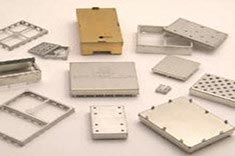EMI Shielding Products
- Custom Gasket Fabrication
- Connector Gaskets
- Bonded O Ring
- Custom Gaskets
- Conduct-O-Knit Knitted Wire Mesh
- Conduct-O-Seal Combo Gasket
- Conduct-O-Elastomer
- Conduct-O-Seal Oriented Wire in Silicone Gasket Material
- Conduct-O-Mesh Tape
- Conduct-O-Foam
- Conduct-O-Bond
- Optical Filters For Electronic Displays
- Shielded Vent Panels
- ESC Board Level Shielding
- 300 Series
Beyond Shielding: How Multifunctional EMI Materials Are Transforming Electronics
 In many work environments, stray electromagnetic waves can wreak havoc on devices, causing unreliable performance and disruptive interference. Picture when a crucial sensor suddenly returns erratic data or a medical monitor stutters at the worst possible time. These glitches are often tied to a hidden source of frustration: electromagnetic interference. It feels discouraging and costly when expensive instruments fail without warning, especially if it puts safety or efficiency at risk. For anyone who has battled these issues, the thought of an all-in-one fix that blocks interference and provides extra benefits seems almost too good to be true.
In many work environments, stray electromagnetic waves can wreak havoc on devices, causing unreliable performance and disruptive interference. Picture when a crucial sensor suddenly returns erratic data or a medical monitor stutters at the worst possible time. These glitches are often tied to a hidden source of frustration: electromagnetic interference. It feels discouraging and costly when expensive instruments fail without warning, especially if it puts safety or efficiency at risk. For anyone who has battled these issues, the thought of an all-in-one fix that blocks interference and provides extra benefits seems almost too good to be true.
A closer look at today's manufacturing and design hurdles shows why better solutions are in high demand. Increasingly smaller devices, higher data speeds, and more crowded electromagnetic environments push engineers toward materials that protect sensitive electronics while minimizing weight and space. This pressure points to one powerful concept: a new class of shielding materials that deliver multiple functions beyond merely stopping interference. Multifunctional EMI shielding materials that integrate sensing, thermal control, or self-heating offer a clear path for tackling complex design needs with a single protective layer.
Why Integrate Extra Functions into EMI Shielding?
Multifunctionality in EMI solutions is not just a buzzword. It aims to answer a practical question: Why install multiple separate layers—one for EMI shielding, another for temperature management, and perhaps another for sensing—when a single, engineered material can handle everything more gracefully? Thin but robust barriers that dissipate heat, measure strain, or manage moisture reduce both bulk and complexity. This streamlined approach helps anyone puzzled over how to fit too many separate parts into an increasingly tight circuit enclosure.
Better still, these combined properties do more than consolidate hardware. A shield that monitors for physical stress or rapidly warms up in a cold setting can prevent failures before they happen. In that sense, it is more than just a functional add-on; it becomes a problem solver. Relying on a single, carefully crafted layer reduces guesswork, parts management, and space constraints. That simplicity can help free up bandwidth to refine other design aspects or speed up a production cycle.
How Do These Materials Move Beyond Traditional Barriers?
The key lies in advanced conductive architectures and the purposeful alignment of different fillers. When carefully arranged, these fillers create paths that absorb or reflect electromagnetic waves while performing an added role, like regulating heat flow or detecting subtle changes in pressure. Such layered or interconnected structures help craft powerful absorption mechanisms for EMI, boost electrical conductivity for fast heat generation, or amplify sensitivity for sensing tasks.
Equally noteworthy is the synergy that emerges when a material's conductivity is fine-tuned for multiple ends. Components that form an electrical network capable of blocking waves can also serve as a sensor's backbone. Similarly, a low-resistance network that mitigates interference may act as a heating element, bringing devices to operational temperatures in cold environments. Each of these capabilities leans on shared design elements—principles that previously may have been overlooked in a single-function shield.
What Benefits Arise for the Wider Industry?
These improvements benefit from electronics packaging, wearable devices, industrial systems, and countless other fields. By incorporating sensing abilities directly into a shielding layer, larger monitoring setups can shrink dramatically. Designers looking to meet tight specifications can count on fewer mechanical add-ons, resulting in more straightforward builds that can still manage robust data collection. Meanwhile, solutions incorporating self-warming properties protect against sudden temperature drops that might otherwise shut down sensitive electronics.
This drive toward multifunctional shielding also raises a new standard of reliability. Early detection of physical stress, quick heat balancing, and robust EMI mitigation all in one means fewer points of failure. Devices become more resilient—vital in scenarios where downtime is simply not an option. As a result, operators no longer have to juggle multiple protective subsystems or worry about conflicting retrofits. One carefully chosen material can match the unique demands of challenging environments, from manufacturing floors to extreme outdoor conditions.
A Compelling Next Step
When shielding is built to tackle multiple problems simultaneously, the door opens to unprecedented efficiency and reliability. This shift from fundamental protective barriers to versatile, multitasking layers addresses many mounting challenges in modern electronics design. Greater integration allows innovators to produce streamlined products that function smoothly and stand firm under ever-changing pressures.
Anyone facing electromagnetic complications or environmental stresses can benefit from exploring these new materials' promise. Finding the right blend of functions can mean fewer disruptions, lower maintenance costs, and more confidence that every piece of equipment will perform as intended. Now is the moment to pursue solutions that block interference and bring other advantages—because managing EMI effectively should never require settling for a shield that does only one thing.



